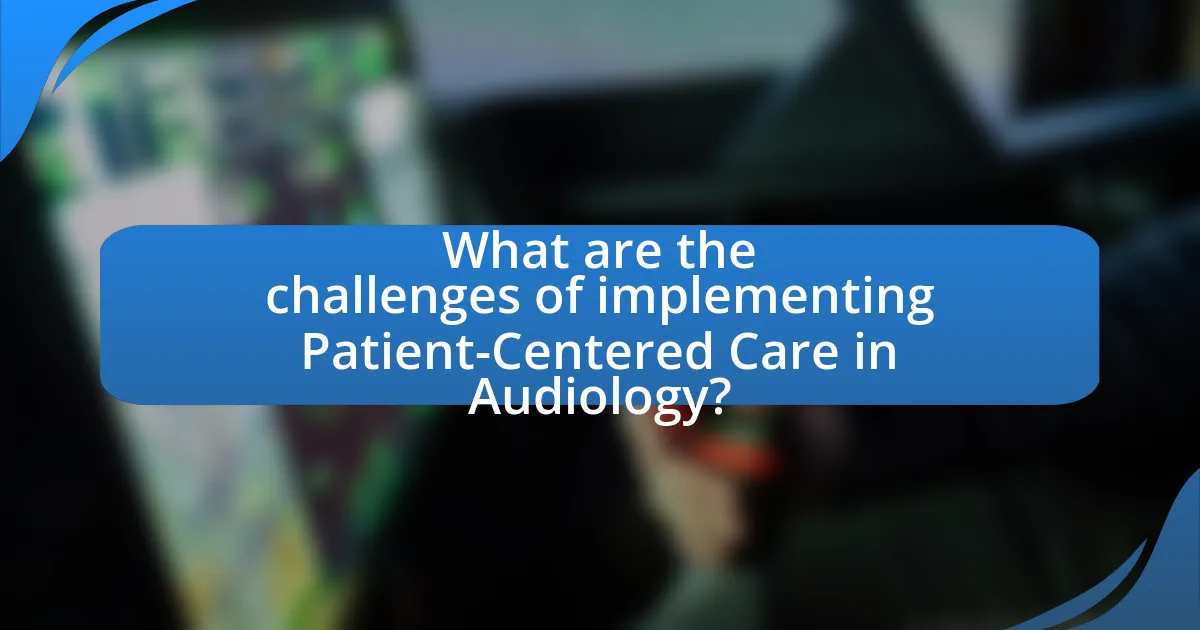Patient-centered care in audiology practices is an approach that emphasizes the individual needs, preferences, and values of patients throughout their hearing healthcare journey. This model fosters active patient involvement in decision-making, leading to improved satisfaction, adherence to treatment, and overall health outcomes. Key principles include respect for patient preferences, effective communication, and emotional support, which collectively enhance the quality of care. The article also addresses the challenges audiologists face in implementing this model, such as time constraints and varying levels of clinician training, while highlighting the role of technology and training in supporting patient-centered practices. Future trends indicate a growing emphasis on personalized care and innovative solutions to improve patient engagement and outcomes in audiology.

What is Patient-Centered Care in Audiology Practices?
Patient-centered care in audiology practices is an approach that prioritizes the individual needs, preferences, and values of patients in their hearing healthcare journey. This model emphasizes active patient involvement in decision-making, ensuring that treatment plans align with their specific lifestyle and communication goals. Research indicates that patient-centered care can lead to improved patient satisfaction, better adherence to treatment, and enhanced health outcomes, as evidenced by studies showing that patients who engage in their care experience greater overall well-being and quality of life.
How does Patient-Centered Care differ from traditional audiology practices?
Patient-Centered Care differs from traditional audiology practices by prioritizing the individual needs, preferences, and values of patients in the decision-making process. In traditional audiology, the focus often lies on clinical protocols and standardized treatments, which may not fully address the unique circumstances of each patient. Research indicates that Patient-Centered Care leads to improved patient satisfaction and better health outcomes, as it fosters a collaborative environment where patients are actively involved in their care. For instance, a study published in the Journal of the American Academy of Audiology found that patients who engaged in shared decision-making reported higher levels of satisfaction with their audiological services.
What are the key principles of Patient-Centered Care in audiology?
The key principles of Patient-Centered Care in audiology include respect for patient preferences, coordination of care, effective communication, and emotional support. Respect for patient preferences ensures that audiologists consider individual patient values and needs in decision-making. Coordination of care involves seamless collaboration among healthcare providers to deliver comprehensive services. Effective communication is essential for understanding patient concerns and providing clear information about hearing health. Emotional support addresses the psychological aspects of hearing loss, fostering a supportive environment that enhances patient engagement and satisfaction. These principles collectively enhance the quality of care and improve patient outcomes in audiology practices.
How does Patient-Centered Care enhance patient engagement in audiology?
Patient-Centered Care enhances patient engagement in audiology by prioritizing the individual needs and preferences of patients, which fosters a collaborative relationship between audiologists and patients. This approach encourages active participation in decision-making regarding their hearing health, leading to improved satisfaction and adherence to treatment plans. Research indicates that when patients feel heard and valued, their engagement levels increase significantly, resulting in better health outcomes and a higher likelihood of following through with recommended interventions. For instance, a study published in the Journal of the American Academy of Audiology found that patient-centered communication strategies led to a 30% increase in patient adherence to hearing aid usage.
Why is Patient-Centered Care important in audiology?
Patient-Centered Care is important in audiology because it enhances patient satisfaction and outcomes by prioritizing individual needs and preferences. This approach fosters better communication between audiologists and patients, leading to more accurate diagnoses and tailored treatment plans. Research indicates that patient-centered practices can improve adherence to treatment and increase the likelihood of positive health outcomes, as patients feel more engaged and valued in their care process. For instance, a study published in the Journal of the American Academy of Audiology found that patients who experienced patient-centered care reported higher satisfaction levels and better hearing aid usage.
What impact does Patient-Centered Care have on patient outcomes?
Patient-Centered Care significantly improves patient outcomes by enhancing satisfaction, adherence to treatment, and overall health status. Research indicates that when patients are actively involved in their care decisions, they report higher satisfaction levels and better adherence to treatment plans. A study published in the Journal of the American Medical Association found that patient-centered approaches lead to a 30% increase in treatment adherence and a 20% improvement in health outcomes. This correlation underscores the effectiveness of Patient-Centered Care in fostering better communication between healthcare providers and patients, ultimately resulting in more favorable health results.
How does Patient-Centered Care improve patient satisfaction in audiology?
Patient-Centered Care improves patient satisfaction in audiology by fostering a collaborative environment where patients actively participate in their treatment decisions. This approach enhances communication between audiologists and patients, leading to tailored care that meets individual needs. Research indicates that when patients feel heard and involved, their satisfaction levels increase significantly; for instance, a study published in the Journal of the American Academy of Audiology found that patient engagement in decision-making correlated with higher satisfaction scores. Thus, the emphasis on personalized care in audiology directly contributes to improved patient experiences and outcomes.

What are the challenges of implementing Patient-Centered Care in Audiology?
Implementing Patient-Centered Care in Audiology faces several challenges, including limited resources, varying levels of clinician training, and patient engagement issues. Limited resources can restrict the availability of time and personnel needed to provide individualized care, impacting the quality of patient interactions. Additionally, clinicians may have differing levels of training in patient-centered approaches, leading to inconsistent application of care principles. Patient engagement is also a significant challenge, as some individuals may be reluctant to participate actively in their care decisions, which is essential for effective patient-centered care. These challenges hinder the full realization of patient-centered care’s benefits in audiology settings.
What barriers do audiologists face in adopting Patient-Centered Care?
Audiologists face several barriers in adopting Patient-Centered Care, including time constraints, lack of training, and insufficient reimbursement models. Time constraints limit the ability of audiologists to engage in thorough patient consultations, which are essential for effective Patient-Centered Care. Additionally, many audiologists report a lack of training in communication skills and patient engagement strategies, which hinders their ability to implement this care model effectively. Furthermore, reimbursement models often do not support the time-intensive nature of Patient-Centered Care, leading to financial disincentives for audiologists to prioritize this approach. These barriers collectively impede the integration of Patient-Centered Care into audiology practices.
How can audiology practices overcome resistance to change?
Audiology practices can overcome resistance to change by actively engaging staff in the change process and providing comprehensive training. Engaging staff fosters a sense of ownership and reduces anxiety associated with new practices. Research indicates that organizations that involve employees in decision-making processes experience a 30% increase in successful change implementation. Additionally, providing training ensures that staff feel competent and confident in using new technologies or methods, which is crucial for patient-centered care. Studies show that practices that prioritize staff education see a 25% improvement in patient satisfaction scores, demonstrating the direct impact of overcoming resistance on patient outcomes.
What role does training play in implementing Patient-Centered Care?
Training is essential for implementing Patient-Centered Care as it equips healthcare professionals with the necessary skills and knowledge to prioritize patient preferences and needs. Effective training programs enhance communication, empathy, and active listening, which are critical components of patient-centered interactions. Research indicates that trained staff are more adept at engaging patients in shared decision-making, leading to improved patient satisfaction and health outcomes. For instance, a study published in the Journal of the American Academy of Audiology found that audiologists who received training in patient-centered approaches reported higher levels of patient engagement and satisfaction. Thus, training directly influences the successful adoption of Patient-Centered Care in audiology practices.
How can technology support Patient-Centered Care in audiology?
Technology can support Patient-Centered Care in audiology by enhancing communication, personalizing treatment plans, and improving access to services. For instance, telehealth platforms enable audiologists to conduct remote consultations, allowing patients to receive care from the comfort of their homes, which is particularly beneficial for those with mobility issues. Additionally, advanced hearing aids equipped with smartphone connectivity allow patients to customize their listening experiences based on their preferences and environments, fostering greater engagement in their care. Research indicates that patient satisfaction increases when technology facilitates active participation in treatment decisions, as seen in a study published in the Journal of the American Academy of Audiology, which found that patients who used interactive tools reported higher satisfaction levels with their audiological care.
What tools are available to enhance communication with patients?
Tools available to enhance communication with patients include telehealth platforms, patient portals, and mobile health applications. Telehealth platforms facilitate real-time consultations, allowing audiologists to connect with patients remotely, which is particularly beneficial for those with mobility issues or in rural areas. Patient portals enable patients to access their health information, schedule appointments, and communicate with their healthcare providers, fostering a more engaged patient experience. Mobile health applications provide resources for hearing health education and reminders for appointments or medication, further supporting patient involvement in their care. These tools collectively improve accessibility, engagement, and satisfaction in patient-centered audiology practices.
How can telehealth improve access to Patient-Centered Care in audiology?
Telehealth can improve access to Patient-Centered Care in audiology by enabling remote consultations, which increases convenience and reduces barriers to care. This approach allows patients to receive timely audiological assessments and interventions without the need for travel, thereby accommodating those with mobility issues or those living in rural areas. A study published in the Journal of the American Academy of Audiology found that telehealth services can effectively deliver audiological care, demonstrating comparable outcomes to in-person visits. This evidence supports the notion that telehealth enhances patient engagement and satisfaction, key components of Patient-Centered Care.

What are the best practices for delivering Patient-Centered Care in Audiology?
The best practices for delivering Patient-Centered Care in Audiology include active listening, individualized treatment plans, and fostering a collaborative relationship between audiologists and patients. Active listening ensures that audiologists fully understand patients’ concerns and preferences, which is crucial for tailoring care effectively. Individualized treatment plans take into account the unique needs and lifestyles of each patient, enhancing satisfaction and outcomes. Additionally, fostering a collaborative relationship encourages open communication, allowing patients to participate in decision-making regarding their care. Research indicates that patient-centered approaches lead to improved adherence to treatment and better overall health outcomes in audiology settings.
How can audiologists effectively involve patients in their care decisions?
Audiologists can effectively involve patients in their care decisions by implementing shared decision-making processes that prioritize patient preferences and values. This approach encourages open communication, where audiologists provide comprehensive information about treatment options, risks, and benefits, allowing patients to express their concerns and preferences. Research indicates that when patients are actively engaged in their care, they report higher satisfaction and better health outcomes. For instance, a study published in the Journal of the American Academy of Audiology found that patients who participated in shared decision-making were more likely to adhere to treatment plans and experience improved hearing-related quality of life.
What strategies can be used to personalize care for each patient?
To personalize care for each patient in audiology practices, strategies include comprehensive assessments, individualized treatment plans, and ongoing patient engagement. Comprehensive assessments involve evaluating not only the audiological needs but also the patient’s lifestyle, preferences, and communication goals, ensuring that care is tailored to their unique circumstances. Individualized treatment plans are developed based on these assessments, incorporating specific interventions that align with the patient’s hearing loss type and personal objectives. Ongoing patient engagement, through regular follow-ups and feedback mechanisms, allows audiologists to adjust care as needed, fostering a collaborative relationship that enhances patient satisfaction and outcomes. Research indicates that personalized care approaches lead to improved adherence to treatment and better overall health outcomes, as highlighted in studies published in the Journal of the American Academy of Audiology.
How can feedback from patients be integrated into audiology practices?
Feedback from patients can be integrated into audiology practices through systematic collection methods such as surveys, interviews, and focus groups. These methods allow audiologists to gather insights on patient experiences, preferences, and satisfaction levels, which can inform service improvements. For instance, a study published in the “Journal of the American Academy of Audiology” found that practices utilizing patient feedback reported enhanced patient satisfaction and better treatment outcomes. By analyzing this feedback, audiologists can tailor their services to meet the specific needs of their patients, ultimately fostering a more patient-centered approach in audiology care.
What are the future trends in Patient-Centered Care within Audiology?
Future trends in Patient-Centered Care within Audiology include the integration of technology, personalized treatment plans, and enhanced patient engagement strategies. The use of telehealth services is expanding, allowing audiologists to provide remote consultations and follow-ups, which increases accessibility for patients. Personalized treatment plans are being developed through data analytics and patient feedback, ensuring that care is tailored to individual needs. Additionally, there is a growing emphasis on involving patients in decision-making processes, which has been shown to improve satisfaction and outcomes in healthcare settings. These trends are supported by research indicating that patient-centered approaches lead to better adherence to treatment and improved quality of life for individuals with hearing loss.
How is the role of audiologists evolving with Patient-Centered Care?
The role of audiologists is evolving to prioritize individualized patient experiences and outcomes through Patient-Centered Care. This shift involves audiologists actively engaging patients in their treatment decisions, tailoring interventions to meet specific needs, and fostering collaborative relationships. Research indicates that patient-centered approaches lead to improved satisfaction and adherence to treatment plans, as evidenced by a study published in the Journal of the American Academy of Audiology, which found that patients who felt involved in their care reported better hearing outcomes and overall well-being.
What innovations are shaping the future of Patient-Centered Care in audiology?
Innovations shaping the future of Patient-Centered Care in audiology include telehealth services, personalized hearing aids, and artificial intelligence-driven diagnostics. Telehealth services enhance accessibility by allowing patients to receive consultations and follow-ups remotely, which has been shown to improve patient satisfaction and adherence to treatment plans. Personalized hearing aids utilize advanced technology to adapt to individual hearing profiles, ensuring a better fit and improved user experience. Additionally, artificial intelligence in diagnostics streamlines the assessment process, enabling audiologists to provide tailored recommendations based on real-time data analysis. These innovations collectively enhance the quality of care and patient engagement in audiology practices.
What practical steps can audiologists take to implement Patient-Centered Care?
Audiologists can implement Patient-Centered Care by actively involving patients in their treatment decisions and tailoring interventions to individual needs. This can be achieved through comprehensive assessments that consider patients’ preferences, lifestyles, and communication needs. For instance, audiologists can utilize shared decision-making tools that facilitate discussions about treatment options, ensuring that patients feel empowered and informed. Research indicates that patient engagement in healthcare leads to improved satisfaction and outcomes, as evidenced by a study published in the Journal of the American Academy of Audiology, which found that patient-centered approaches significantly enhance adherence to treatment plans. Additionally, audiologists should provide ongoing support and follow-up to address any concerns, reinforcing a collaborative relationship that prioritizes the patient’s voice in their care journey.


